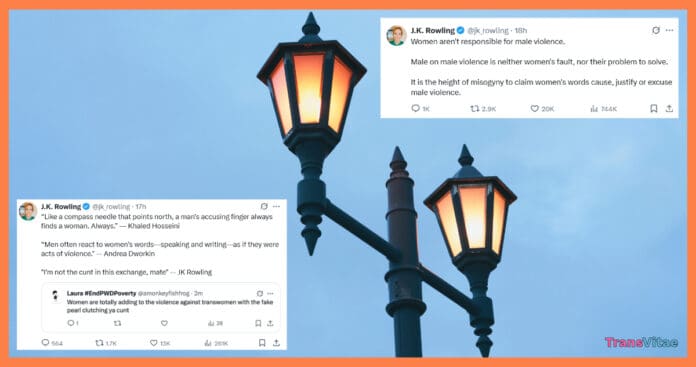When news broke this week that another transgender woman was killed in what authorities are investigating as a hate-motivated attack, most responses reflected heartbreak, solidarity, and urgent calls for justice. But for J.K. Rowling, it was just another opportunity to double down on the idea that she, not the trans community, is the real victim.
In a now widely circulated post on Twitter, Rowling responded to a report about the murder by deflecting all responsibility for the rise in anti-trans violence, writing:
“Women aren’t responsible for male violence.
Male on male violence is neither women’s fault, nor their problem to solve.
It is the height of misogyny to claim women’s words cause, justify or excuse male violence.”

The message, eerily calm, almost rehearsed, is the latest in Rowling’s long history of using feminist language to dodge responsibility for her own inflammatory rhetoric. It’s a tactic increasingly seen across the “gender critical” (GC) and TERF spheres: reframing any criticism of their speech as male aggression and casting themselves as innocent, intellectual observers of the chaos they helped ignite.
But Rowling wasn’t done. In a follow-up tweet, she quoted The Kite Runner, radical feminist Andrea Dworkin, and, naturally, herself:
“Like a compass needle that points north, a man’s accusing finger always finds a woman. Always.” — Khaled Hosseini
“Men often react to women’s words—speaking and writing—as if they were acts of violence.” — Andrea Dworkin
“I’m not the cunt in this exchange, mate.” — J.K. Rowling

The message? If you’re upset, you’re overreacting. If you’re calling her out, you’re just another man silencing a woman. If a trans woman is murdered, it’s tragic but certainly not influenced by the cultural climate fueled by Rowling’s years of trans-hostile commentary.
Let’s call the situation what it is: gaslighting. It’s not revolutionary feminist theory. It’s not brave dissent. It’s a polished PR playbook designed to deflect criticism and create a false narrative where the people harmed by rhetoric are the real aggressors.
Rowling and her defenders have long claimed that “words aren’t violence,” but somehow, any criticism of her words is framed as violent or misogynistic. It’s a double bind, and it’s exhausting. But most importantly, it’s dangerous—because these narratives downplay the very real threats trans people face every day.
So… How Do You Respond to This Nonsense Without Losing Your Mind?
If you’re tempted to clap back at Rowling or anyone in the GC camp, you’re not alone. But before hitting “reply,” consider these smarter responses:
- Ask Questions Instead of Arguing: Try: “If your speech has no influence, why are you so invested in saying it?” or “Why is it only trans people who are blamed for violence they suffer?”
- Share Facts, Not Feelings: Point to studies showing the correlation between anti-trans rhetoric and real-world harm. Let the evidence speak louder than their spin.
- Use Humor or Snark, Strategically: Sometimes, a well-placed “OK Voldemort” or “You wrote a wizard book, not a manifesto” can do more than any 10-paragraph thread.
- Know When to Log Off: You don’t have to respond. Protect your peace. Rowling isn’t going to change her mind—but you can choose not to feed the algorithm.
At the end of the day, we can’t control what J.K. Rowling tweets. But we can name the tactic, reject the gaslight, and shine a light on the harm that continues when powerful voices speak without accountability.
Stay loud. Stay safe. Stay magical, no matter what the author says.


